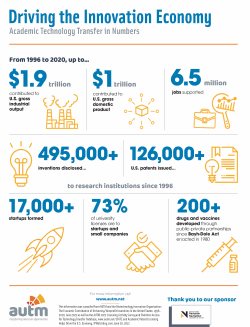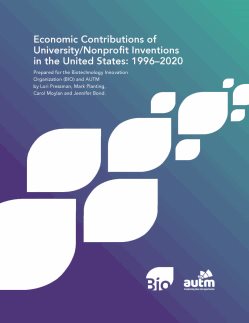Providing Support to TTO Directors
One of the hardest parts of any tech transfer Director’s job is making the case to university leadership and others about the value, seen and unseen, of technology transfer. To help you better communicate the significant impacts that your office provides both to society and the economy, AUTM has put together this Director's Toolkit. It is designed to define the modern view of the profession in a way that makes sense to those inside and out of technology transfer, distill key messages to stakeholders, and ultimately help you communicate tech transfer’s intrinsic importance to the world.
Defining Tech Transfer
The process of commercializing academic research and putting innovations to use for the public good, is called “technology transfer.” It’s a complex field that requires knowledge and expertise relating to intellectual property protection and licensing, corporate engagement, start-up business creation and economic development. The objective of technology transfer is to support innovation and economic growth by translating university research into marketable products and services that impact society.
In short, technology transfer is about advancing ideas from research institutions into the marketplace to stimulate the economy and benefit society. Consider sharing this video, which explains the basics of tech transfer, with reporters, academics and university leadership.
The TTO Evolution
Technology transfer is evolving, and TTO Directors’ approach with stakeholders must change too. It is therefore important to share with your leadership that gone are the days when TTOs were tasked primarily with protecting inventions with patent applications and licensing out those inventions. Today, many TTOs ─ which now include government labs and hospitals, and their industrial counterparts ─ are responsible for business development and start-up formation, industry collaborations and partnerships. Moreover, many have a sharp focus on economic development and, for many more, their organizations recognize that the TTO is not a profit center but an integral part of the institution in support of research, student development, faculty retention, and the dissemination of knowledge.
Reframing the Narrative
If there is one message that AUTM encourages you to repeat, often, with the press, with policymakers, with your bosses, it’s this: Technology transfer is about impact, not income. That’s because too often, the conversation turns to the number of patents issued, licenses and income generated. If you represent a small TTO in a rural university, the size and scope of those impacts is of course going to be fundamentally different than those of a university with more than $500 million in research in a major population center. Instead, we encourage you to focus on metrics that show how your TTOs is creating an annuity of goodwill that is relevant to your local ecosystem.
Share this benefits and impacts doc with your boss

| Consider: |
| How your office is enhancing the research reputation of the university and your faculty |
| The number of companies started as a result of tech transfer on your campus |
| The things that show how your research is transforming lives |
| New drugs headed into the clinic and promising new technologies |
| Agricultural innovations that help feed the world |
| Corporate partnerships you’ve helped develop |
| The translation of research into commercial products through start-up formation and capital raised |
| Local economic development — creating new ventures that hire more people |
| Capital infusions into your state through SBIR and venture funding |
| Faculty recruitment and retention, as well as the placement of trailing spouses |
In pursuit of new metrics
Tech transfer professionals are part midwife, part matchmaker. Their essential impacts, if they do their jobs well, are largely as silent catalysts. So how do you explain the impact of tech transfer when much of the work your staff does to forward academic research innovation is behind the scenes? And how do you create metrics that are able to be contextualized to your local market?
Measures used to track outcomes tend to be quantitative and to focus on the direct outputs from the processes of tech transfer. Traditionally, these might be in the form of inventions disclosed, patents filed, licenses executed, start-ups formed and revenue generated (see AUTM’s Annual Licensing Survey and annual infographic for these stats).
But numbers simply aren’t enough to tell the whole story in such a complicated field. Basic metrics are not sufficient for policymakers and academic leadership to fairly judge the success of tech transfer, where the greatest return on investment is derived largely from the longer-term outcomes (often 20-50 years) that deliver societal and economic benefit.
You have to go beyond the core numbers to consider how lives have been improved.
| A focus on new metrics might include: |
| The happiness/satisfaction of internal and external customers |
| The number of lives affected/improved |
| The reputation of your university (academic/research organization, etc.) |
| The repeat/referral business to your TTO |
| Local jobs created |
| Stories of your TTOs success (see the AUTM Better World Project) |
| How many deals are completed per staffer |
| A high office productivity rate for the number of cases filed |
Here you'll find detailed information on the fundamentals of technology transfer, with downloadable information for you to digest and share.
Discover how academic technology transfer is driving the innovation economy and benefiting society. with commercial potential. Every year university research yields discoveries.


Download and share this infographic.
Share your own impact data with this customizable infographic: Just add your office's numbers to the new blank tech transfer life cycle.

Download the fillable infographic for your own use.
Learn the benefits and impacts of technology transfer and learn what you can do to enhance it at your institution.

Download and share this info sheet.
Discover the economic contribution of university/nonprofit inventions in the United States.

Download and share the AUTM BIO report.
Use this PowerPoint presentation to describe the role of the tech transfer office.